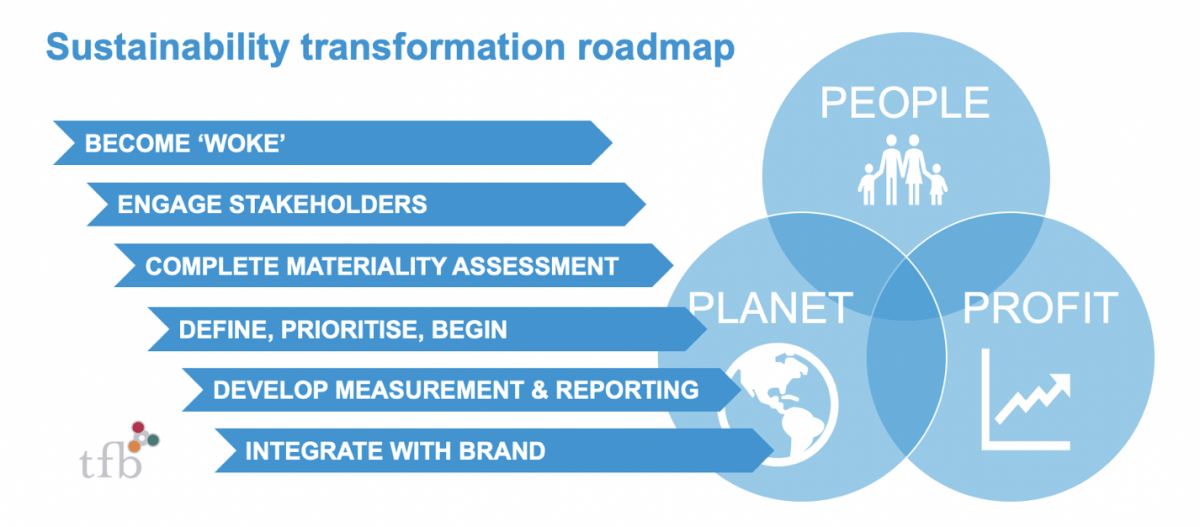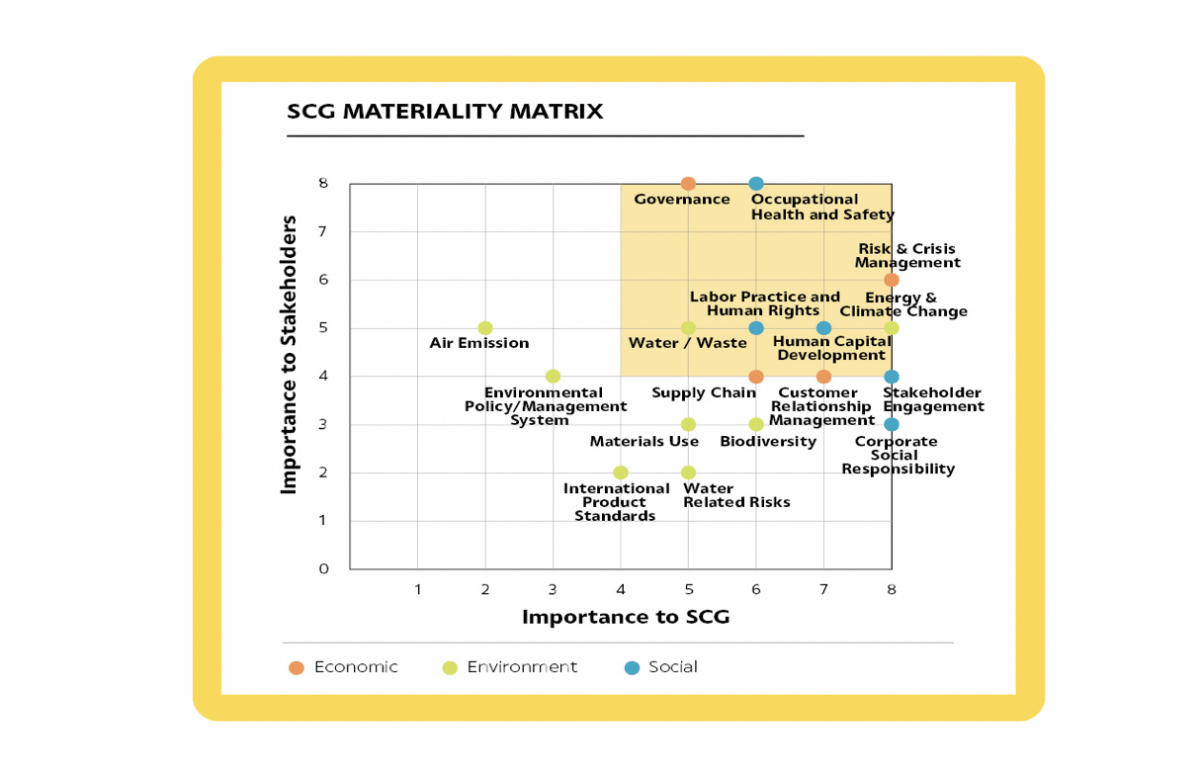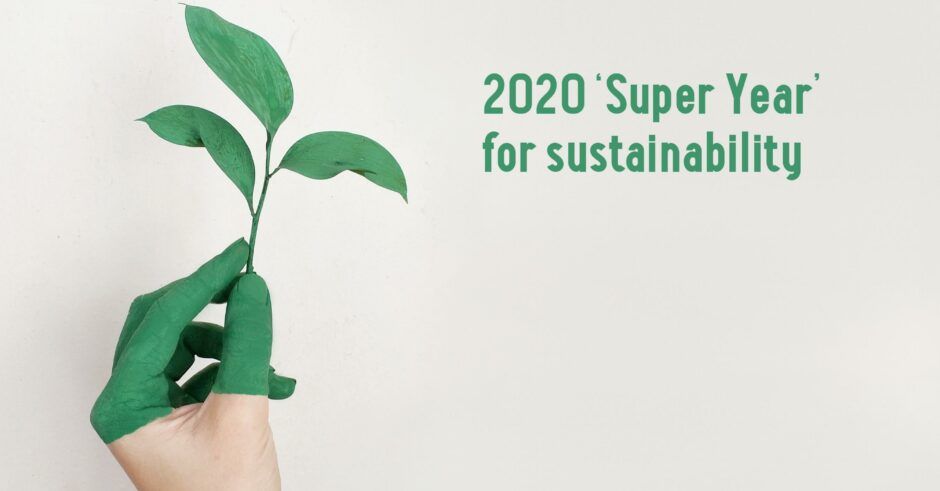How do we get there? There can be much to consider under each key step in a sustainability transformation roadmap but we will keep to a high-level overview for this blog and more detail can be explored in future blogs on each step. The typical roadmap towards becoming a sustainable organisation can be seen below:

- Become ‘woke’ as a business
Becoming ‘woke’ is some good street lingo meaning ‘consciously awake’. In this context, it is used to mean having an understanding of your particular sustainability challenges by benchmarking in your industry. Start by scanning your environment to learn what other companies in your sector are doing and their best practices. Survey where you are and your status quo against your industry’s benchmarks. Once you’re ‘woke’, then move to engaging your stakeholders.
- Engage Stakeholders
It is fundamentally important to engage both internal stakeholders such as employees and also external stakeholders such as investors and customers. Start by creating an internal dialogue in the organisation by asking questions like:
- What type of sustainable organisation do we want to be?
- What does sustainability mean for us?
- Why is it important?
- What is our business case?
Note that sustainability is starting to be pushed bottom up in organisations by employees. Last month, over 1,000 employees at Google signed and sent a letter to their bosses demanding climate change action.
Engaging stakeholders will help you assemble ideas, gain data and contribute to defining the sustainability vision you want communicated both internally and outwardly in the marketplace.
Top Tip! Determine who owns sustainability in your organisation. There are several ways to approach this but a hybrid approach is recommended. You may decide to have a CSO (Chief Sustainability Officer) or a board-level sustainability committee but also consider how you embed sustainability more deeply so it’s viewed as everyone’s job. No one should think sustainability is the job of Joe or Jane over there because he or she is the sustainability manager. Don’t make the mistake of sustainability being devolved down to a job title.
3. Complete materiality assessment
Now you want to complete what is called a materiality assessment or a materiality matrix. Don’t let that concept overwhelm you. You are simply determining what’s important to manage and measure through a defined prioritisation process. You are basically assessing risks and opportunities to determine the best way to operate. Below, is an example from SCG (Siam Cement Group), the second-largest company in Thailand. Here they’ve plotted their key ESG themes against the vertical axis of ‘importance to stakeholder’ and the horizontal axis of ‘importance to SCG’ giving them some priorities like Occupational Health & Safety and Energy & Climate Change.

4. Define, prioritise, begin
Once you know what you’re focusing on, it’s about strategising and road mapping. Think of this as green transformation maps to facilitate the step-by-step process of your company becoming green in specific areas such as Operations, Supply Chain, Logistics and Products & Services. Depending on your business, you will be prioritising objectives and change processes such as:
- Reducing energy and water consumption
- Reducing CO2 emissions due to corporate activities
- Creating sustainable supply chains and closed-loop systems
- Modifying accounting and control systems
- Changing incentive systems
Top Tip! It’s not only about the big items. You want to gain momentum. Find areas for initial steps or low-hanging fruit, for example, decreasing paper usage or auto switch off of lights in the building. Everything contributes. Just get a momentum going.
5. Develop measurement & reporting
Then there is the need to develop measurement and reporting systems. Start by collecting data on factors such as types of changes made, impacts recognised, stakeholder satisfaction levels and certainly performance metrics (knowing those are economic, social and environmental). Remember they say ‘what gets measured, gets done’.
Depending on the size and complexity of your business, consider GRI (Global Reporting Initiative) and IR (Integrated Reporting). These help guide you to your sustainability goals and transparency. GRI is one of the most used reporting frameworks with 75% of the world’s largest 250 companies currently using it. You can also consider implementing a formal EMS (Environmental Management System), which allows you to further articulate your goals and measure progress. For some organisations, it’s best to consider formal certification, for example, product certifications or ISO14001, which is the world’s most recognised environmental standards.
Now – warning! This can be one of the most confusing areas of sustainability. There’s a lot of confusion and contention in the market at the moment due to the fact there ARE so many ratings, standards, frameworks and indices out there.
Two top tips here! Firstly, start with small pilot projects. Perhaps starting with a subsidiary, if you have one, or just one business unit and then you can measure against other units later. Secondly, when you undertake the very first step mentioned of becoming ‘woke’ and you are benchmarking, and surveying sustainability in your industry, see which frameworks are most used in your sector and for companies most similar to yours.
6. Integrate with brand
Now, lastly, you want to integrate with brand. This is about creating your sustainability narrative. You want to communicate a sustainability vision and your company’s sustainability story that’s relevant and compelling for all of your audience. It is important to tie those messages to the strategic goals of your company, integrate into your annual report and create marketing and communications. Basically, you want to shout about it! Not only do businesses need to be more sustainable, they also need to effectively communicate their commitment. That’s because investors, customers, and employees demand transparency and are actively seeking out companies that align with their values. They will penalize companies that fail to show how sustainable they are and reward the ones that have put a public stake in the ground.
Note that sustainability is really changing the investment world. You may have heard of SRI (Socially Responsible Investment) or ESG investing or Impact Investing. In a capitalistic or market-driven economy, many say if you really want change, then ‘follow the money’. Well, investors are starting to ask: What’s my money doing when I’m not looking?
Top Tip! The number of corporate sustainability reports published each year has increased exponentially over the past decade and the trend for large companies to include sustainability information in their annual financial reports continues to grow. The vast majority (about 80%) of the world’s top 250 companies now do this.
Sustainability is just good business
Business leaders everywhere need to realise that we are now moving on from tree-hugging, climate protests and climate change news headlines. Sustainability strategies are for business survival, not just the planet’s survival. Adopting sustainable practices not only helps the environment but corporations are proving that sustainability initiatives lead to an improved brand image, competitive advantage, happier shareholders and access to green investment – sustainability is just good business. Make 2020 your super year!
If you missed it, you can read Part 1 here.




